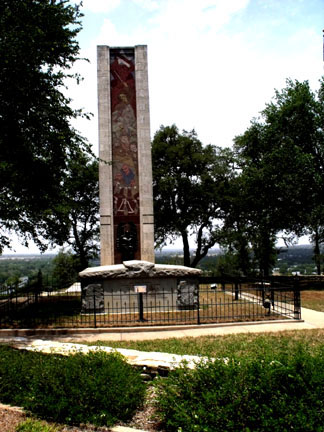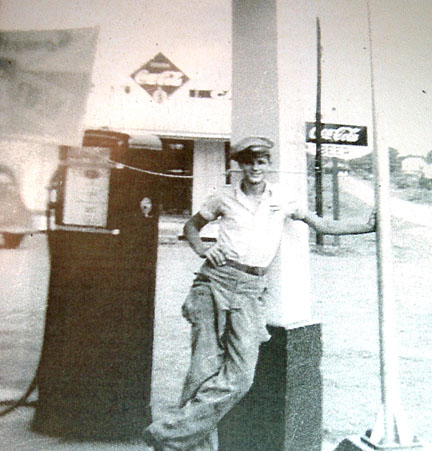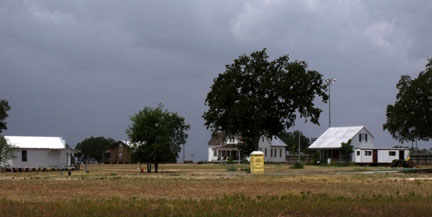|
History of La Grange, Fayette County, Texas
 












HISTORY OF LA GRANGE

By Leonard Kubiak, author and Texas Historian of Rockdale, Texas

EARLY HISTORY OF FAYETTE COUNTY
The region that became Fayette County was home to Lipan Apaches and Tonkawa Indians who inhabited the Fayette County region for centuries prior to the arrival of the European settlers. Many Indian artifacts found near Little Pin Oak Creekincluding Clovis and Plainview points (dating back some 10,000 years, and other later artifacts dating to the early 1800s.
In the early eighteenth century Spanish explorers passed through the area. La Bah�a Road, which ran southwest to northeast and crossed the river at the site of present La Grange, was the major route for travel during the Mexican period.
The area was also part of Stephen F. Austin's first colony, but the earliest known white settlers, Aylett C. Buckner and Peter Powell, arrived earlier and lived on La Bah�a Road west of La Grange, where they ran a trading post.
Formal settlement of the Fayette County region began in 1822 with the arrival of the Austin colonists. From 1824 to 1828 ten members of the Old Three Hundred received title to their land grants in the fertile Colorado River valley; William Rabb received four leagues in order to build a mill.
A total of ninety-two Mexican land grants were granted in the area that is now Fayette County. The earliest settlers gathered at Wood's Fort, Moore's Fort (La Grange), the James Ross home, and Jesse Burnam's blockhouse, twelve miles below La Grange. Burnam's Ferry on the Colorado River provided a cutoff route from La Bah�a Road to San Felipe. Prior to Texas independence, the area above La Bah�a Road was in the Mina Municipality and the area below in the Municipality of Colorado. Gotier's Trace, the Wilbarger Trace, and the La Grange-San Felipe road intersected La Bah�a Road. Ferries were used to cross the Colorado River until the first bridge was built at La Grange by private subscription in 1883.
On December 14, 1837, upon petition of the citizens, the Congress of the Republic of Texas established the county of Fayette, named in honor of the Marquis de Lafayette. La Grange, the name of the chateau to which Lafayette retired, was designated the county seat. The citizens organized the county government on January 18, 1838, and the southwestern boundary of the county was extended westward on May 3, 1838. The county lost territory in the south to Lavaca County in 1854 and in the north to Lee County in 1874.
The early settlers' life revolved around their plantations, but not surprisingly, problems with Indians occupied much of their time. Sometimes the settlers felt so threatened that they moved down to the lower Colorado River area. At other times they grouped together, sometimes aided by Lipan Apache and Tonkawa Indians who were friendly to the settlers, to resist marauding bands of Comanches, Wacos, and Kichais. Fayette County men were prominent in the Texas Revolution; more than fifty men participated in the battle of San Jacinto, including Joel Walter Robinson, one of the captors of Antonio L�pez de Santa Anna.v The Somervell, Mier, and Dawson expeditions were composed mostly of Fayette County men.
In 1848 the remains of the men killed in the Dawson Massacre and in Perote Prison were returned to Fayette County and interred on Monument Hill; in 1933 a granite tomb was dedicated there. The historic Muster Oak, still standing on the square, has been a rallying site since the early settlement. William Menefee, a signer of the Texas Declaration of Independence, was from Fayette County. A proposal to permanently locate the state capital in Fayette County was approved on April 11, 1838, by an overwhelming majority of the Second Congress. Local citizens arranged for the purchase of the Eblin league on the east side of the Colorado River near La Grange, reserving all vacant lands within a nine-mile radius. The measure was vetoed by Sam Houston, however, and the capital was located upriver near Waterloo which later became Austin.
The tide of German, Czechs, and Bohemian immigrants in the 1880s changed the ethnic makeup of Fayette county with the majority being German settlers (3,667) and Czech settlers from Austria-Hungary (3,224). As a result, by the late nineteenth century many of the leading businesses and civic organizations were dominated by Germans and Czechs.
During the late nineteenth and early twentieth centuries La Grange had two foreign-language newspapers, the Svoboda (Czech) and the La Grange Zeitung (German). The Germans and Czechs formed shooting clubs, poetry groups, and fraternal and religious organizations. The KJT (Czech Catholic Union), the SPJST (a Czech benevolent society), and the Round Top Rifle Association, founded in the nineteenth century, still existed in the early 1990s.
EARLY HISTORY OF LA GRANGE
La Grange was established near the site where La Bah�a Road crossed the Colorado River. The first known European settler in the region was Aylett C. Buckner who settled near the Colorado River about 1819. In 1826, John Henry Moore built a twin blockhouse he called Moore's Fort which area settlers came to depend on for shelter from Indian attacks.
LA GRANGE ESTABLISHED IN 1837
By 1831 a small community developed around Moore's Fort and in 1837, the settlement of La Grange was platted. In 1838, the Congress of the Republic of Texas established Fayette County and area citizens voted to name La Grange as the county seat. The county had been named after the Marquis de Lafayette, and the county seat took its name from his chateau. A post office was established at La Grange in 1838, and that same year the Texas Congress passed a bill intended to place the capital of the Republic of Texas on a site contiguous with La Grange, but the bill was vetoed by Sam Houston.
La Grange grew as a trade center for the area's developing plantation economy. Its first newspaper, the La Grange Intelligencer, began to publish in 1844, and in 1846 the La Grange Female Institute was established. The first Methodist and Presbyterian congregations in La Grange were organized in the 1840s. La Grange was incorporated in 1850, and by 1855 it had four major schools, including the La Grange Academy and the La Grange Male and Female Seminary and Boarding School.
GERMAN AND CZECH SETTLERS POUR INTO FAYETTE COUNTY
By the 1850's, the word was out in central Europe that Fayette County was a Czech and German friendly region and increasing numbers of Germans and Czechs immigrated into the county. The first Lutheran service in La Grange was conducted in 1851, and in 1859 the Casino Association of La Grange opened the area's first German Free School. In 1860 Heinrich Kreische, a German immigrant from Saxony, established in La Grange one of the state's first commercial breweries.
LA GRANGE AND THE CIVIL WAR
Though many of the German immigrants in the area were against slavery, the plantation economy of Fayette County influenced many La Grange residents to support southern rights as they understood them in the years leading up to the Civil War. In early 1861, when the Civil War began, a number of militia companies were organized at La Grange to aid the Confederate cause. Some of the Germans in La Grange fled to Mexico or returned to Germany; still others formed the La Grange German Company, organized as a State Reserve unit in July 1861.
RECONSTRUCTION WAS A TURBULENT PERIOD FOR FAYETTE COUNTY
Though La Grange and much of Fayette County was untouched by fighting during the Civil War, the town was torn by conflict and disorder during reconstruction.
The local peace was disrupted in May 1865 as returning Confederate veterans robbed local German businesses, provoked arguments and fights, and, on one occasion, threatened to burn down the town. La Grange was occupied by federal troops in 1866, and an agency of the Freedmen's Bureau was established there to protect the rights and welfare of the many freed slaves in the surrounding area.
Friction between the federal authorities and ex-Confederates in the town led to a number of altercations that sometimes, as one source put it, "reached the proportions of a first-class riot."
YELLOW FEVOR EPIDEMIC STRIKES LA GRANGE (1867)
From August to December 1867 La Grange was ravaged by a deadly yellow fever epidemic that killed 240 people-about 20 percent of its population at the time. Some of the dead were buried in mass graves.
La Grange began to grow again as a trade center during the late 1800s, with arrival of the Galveston, Harrisburg and San Antonio Railway in 1880 and the city's first bridge across the Colorado River was completed in 1883. Though the arrival of the railroad helped to put the Kreische Brewery out of business,
it was generally good for the growth of La Grange.
By 1884 the city included four churches, three schools, an opera house, an oil factory, and a bank. Its population had grown to 1,800, and two weekly newspapers, the Journal and the Slovan (a Bohemian paper), were being published. Two more banks were established in La Grange during the late 1880s, facilitating the local cotton trade and strengthening the city's position as a shipping center.
LA GRANGE BOOMS IN LATE 1890s
A three-story stone county courthouse was completed in 1891. By 1896 the city had electric service and a waterworks, as well as the opera house, two bridges, four schools, five churches, three banks, three gristmills and cotton gins, and three newspapers, including the Deutsche Zeitung, a German-language publication. By 1900 some 2,392 people lived in La Grange.
CHICKEN RANCH
La Grange received national attention during the late 1970s and early 1980s when the story of the Chicken Ranch was publicized through the Broadway production of The Best Little Whorehouse in Texas and by the movie starring Dolly Parton and Bert Reynolds.

The brothel that became the Chicken Ranch opened in La Grange in 1844. The brothel operated out of a hotel near the local saloon and featured three young women from New Orleans, Louisiana. The brothel was successful for over a decade, but was forced to close during the Civil War. After the war, prostitution was endemic in the local saloons.
In 1905, Jessie Williams, ("Miss Jessie") bought a small house along the banks of the Colorado River and opened a brothel maintaining a good relationship with local law enforcment and admitting politicians and lawmen. After receiving word of an imminent crusade against the red-light district, Williams sold her house and purchased 10 acres just outside the city limits of La Grange, and only two blocks from the Houston-Galveston highway.

The brothel looked like a typical Texas farmhouse, with whitewashed siding and a few side buildings, which held the chickens. The entrance was located in the back of the house, and led to a house with fourteen rooms. No lights or signs indicated that the building housed a brothel.
During the Great Depression, Williams implemented the "poultry standard," charging one chicken for each sexual act. The number of chickens at the brothel exploded, and soon the place became known as the Chicken Ranch. Williams supplemented her income by selling surplus chickens and eggs.
In the 50's, the Chicken Ranch was highly successful employing sixteen prostitutes. On weekends there was often a line of men, mostly students or soldiers from nearby military bases, at the door.

One base supplied a helicopter for soldiers to use for transportation to the ranch. Students at Texas A&M University also made an unofficial tradition of sending freshmen to the Chicken Ranch for inititation. The Chicken Ranch was preferred because many of the girls were allegedly University of Texas students.
In July of 1973, Houston television reporter Marvin Zindler began an investigation of the Chicken Ranch. Zindler approached Texas Governor Dolph Briscoe about the matterand Briscoe and Texas Attorney General John Hill ordered the Chicken Ranch to be permanently closed on August 1, 1973. The house was purchased by two Houston lawyers and moved to Dallas, where it was opened as a restaurant.
MONUMENT HILL-KREISCHE BREWERY STATE HISTORIC SITE
In 1842, the Mexican army attacked the Republic of Texas and catured the city of San Antonio. Nicholas Dawson and a militia of 54 men mostly from Fayette County marched toward San Antonio to join in the fight. As the Texas militia approached the battlefield, they were attacked and most of the men were killed in what is now called the Dawson Massacre. Three men escaped and 15 men were taken prisioners and marched on foot to Perote Prison near Vera Cruz in Southern Mexico.
In the winter of 1842, a little over 300 Texas soldiers marched into Mexico to avenge the massacre. They attacked Mexican soldiers in the border town of Ciudad Mier. After a fierce battle, some 250 Texans were captured and marched toward Mexico City. Within a few weeks, most of the men escaped but were recaptured in the dry hot desert region. Santa Anna ordered them all excuted but diplomatic efforts from the US and Great Britain resulted in a compromise known as the black bean lottery (one out of every ten escapes would be executed). The captured escapes drew beans from a pot containing 159 white beans and 17 black beans. Those drawing black beans were executed by firing squad. The white bean survivors were taken to Perote Prison.
In 1846, Texas became a state and the US army immediately went to war with Mexico. During the war, the Black Bean victims bodies were brought back to La Grange and burried alongside the bodies the Dawson Massacre soldiers in a common tomb at Monument Hill. The funeral took place on September 18, 1848.
HEINRICH KREISCHE PURCHASES HISTORIC SITE
In 1849, German immigrant Heinrich Kreische bought 172 acres overlooking the Colorado just south of the town of La Grange to build a home and business. His land purchase included the Dawson/Mier tomb. Kreische maintained the tomb which became known as Monument Hill and built a brewery in the ravine below the hill. Kreische's Bluff Beer became the 3rd largest in the state by the early 1880's. Heinrich died in 1882 in an unfortunate wagon accident leading to the demise of the bewery. .
HEINRICH KREISCHE BREWERY AND MONUMENT HILL PARK
Today the brewery and monument hill are all part of the Texas Parks & Wildlife which has transformed the site into a beautiful park complete with walking trails, picnic sites, rest rooms and senic overlooks. ....a real Texas treasure.







LA GRANGE TODAY
Today, La Grange is nestled along the Colorado River with dozens of fully restore old homes amid beautiful old oak and pine trees.






The three story courthose on the town square has been fully restored and is a sight to behold. Nearby is the old Fayette County Jail that is now home to the La Grange Chamber of Commerce.



TEXAS CZECH HERITAGE & CULTURAL CENTER
My wife and I recently had the pleasure of visiting with Georgia Funderburk at the Texas Czech Heritage and Cultural Center on the outskirts of town on the Fayette County Fair Grounds where we discovered an entire Czech town being reborn.

Old Czech homes and businesses are being moved to the site and will eventually form a complete Czech town from the 1800's. The site already contains several old homes and businesses including the Kalich House that is presently used as the visitor's center with library and giftshop.

The Kalich house, donated to the Texas Czech Heritage and Cultural Center by Peggy and Jonathan Kalich of Schulenburg, was moved onto the site by Kana Brothers Movers and restored by volunteers from throughout the state. The Kalich House now serves as the official TCHCC Visitors� Center, Gift Shop, Library, Display Area, and Office until the new museum/archives facility is completed.
The Kalich Visitor's Center includes a gift shop, Czech culture museum and a great libraryfor genealogical research. The library section includes a major collection of Czech books recently donated by Donna and Guenter Merkle of Houston. Flying in front of the Kalich House are the American, Texas, and Czech flags donated by several Board members and their families.
The Czech village is located at the entrance to the Fayette County Fairgrounds on Highway 77 North, one-quarter mile north of intersection of Highways 77 and the Highway 71 Bypass.
The Kalich House is open to the public Monday through Friday from 10:00 in the morning until 4:00 in the afternoon. For more information call (toll-free): 1-888-785-4500.







The site also includes the Sanford Schmid Amphitheater with an impressive seating capacity of 400. Other buildings currently in place include an old log barn, the Migl house, the Hoelscher Haus, a Wallschian bell and belfry, the Bucek store, and a bridge over a dry creek.

This is a work in progress. Bookmark this page and come back often. If you have old photographs of La Grange or other nearby settlements or families, please email me a copy and I'll include your photos on this webpage.
Thanks
Leonard Kubiak
 For questions or comments, send me an Email BR>lenkubiak.geo@yahoo.com For questions or comments, send me an Email BR>lenkubiak.geo@yahoo.com
|


![]()


![]()